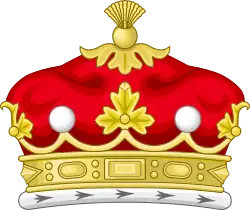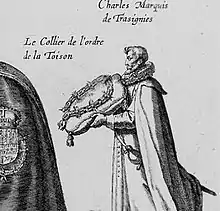Marquess
A marquess (UK: /ˈmɑːkwɪs/;[1] French: marquis, [mɑʁki])[2][lower-alpha 1] is a nobleman of high hereditary rank in various European peerages and in those of some of their former colonies. The term is also used to translate equivalent Asian styles, as in Imperial China and Imperial Japan. The German language equivalent is Markgraf (Margrave).
Etymology
.jpg.webp)
The word marquess entered the English language from the Old French marchis ("ruler of a border area") in the late 13th or early 14th century. The French word was derived from marche ("frontier"), itself descended from the Middle Latin marca ("frontier"), from which the modern English words march and mark also descend. The distinction between governors of frontier territories and interior territories was made as early as the founding of the Roman Empire when some provinces were set aside for administration by the senate and more unpacified or vulnerable provinces were administered by the emperor. The titles "duke" and "count" were similarly distinguished as ranks in the late empire, with dux (literally, "leader") being used for a provincial military governor and the rank of comes (literally "companion," that is, of the Emperor) given to the leader of an active army along the frontier.
Belgium
The title of marquess in Belgium predates the French Revolution and still exists today. See Belgian nobility § Marquesses in the Belgian nobility and List of noble families in Belgium § Marquesses.
Spain
Currently in Spain the rank of Marquess/Marchioness (Marqués/Marquesa) still exists. One hundred forty-two of them are Spanish grandees. Normally a marqués is addressed as "Illustrious Sir" (Ilustrísimo Señor), or if he/she is a grandee as "Your Excellency" (Excelentísimo Señor). Examples include the Marquess of Mondejar, Grandee of Spain.
United Kingdom
The honorific prefix "The Most Honourable" precedes the name of a marquess or marchioness of the United Kingdom.[3]
In Great Britain, and historically in Ireland, the correct spelling of the aristocratic title of this rank is marquess (although on the European mainland and in Canada, the French spelling of marquis is used in English). In Scotland, the French spelling is also sometimes used. In Great Britain and historically in Ireland, the title ranks below a duke and above an earl. A woman with the rank of a marquess, or the wife of a marquess, is called a marchioness /ˌmɑːrʃəˈnɛs/[4] in Great Britain and Ireland, or a marquise /mɑːrˈkiːz/ elsewhere in Europe. The dignity, rank or position of the title is referred to as a marquisate or marquessate.

The theoretical distinction between a marquess and other titles has, since the Middle Ages, faded into obscurity. In times past, the distinction between a count and a marquess was that the land of a marquess, called a march, was on the border of the country, while a count's land, called a county, often was not. As a result of this, a marquess was trusted to defend and fortify against potentially hostile neighbours and was thus more important and ranked higher than a count. The title is ranked below that of a duke, which was often largely restricted to the royal family.
The rank of marquess was a relatively late introduction to the British peerage: no marcher lords had the rank of marquess, though some were earls. On the evening of the Coronation of Queen Victoria in 1838, the Prime Minister Lord Melbourne explained to her why (from her journals):
I spoke to Ld M. about the numbers of Peers present at the Coronation, & he said it was quite unprecedented. I observed that there were very few Viscounts, to which he replied "There are very few Viscounts," that they were an old sort of title & not really English; that they came from Vice-Comites; that Dukes & Barons were the only real English titles; — that Marquises were likewise not English, & that people were mere made Marquises, when it was not wished that they should be made Dukes.[5]
Equivalent non-Western titles
Like other major Western noble titles, marquess (or marquis) is sometimes used to translate certain titles from non-Western languages with their own traditions, even though they are, as a rule, historically unrelated and thus hard to compare. However, they are considered "equivalent" in relative rank.
This is the case with:
- In ancient China, 侯 (hóu) was the second of five noble ranks 爵 (jué) created by King Wu of Zhou and is generally translated as marquess or marquis. In imperial China, 侯 (hóu) is generally, but not always, a middle-to-high ranking hereditary nobility title. Its exact rank varies greatly from dynasty to dynasty, and even within a dynasty. It is often created with different sub-ranks.
- In Meiji Japan, 侯爵 (kōshaku), a hereditary peerage (kazoku) rank, was introduced in 1884, granting a hereditary seat in the upper house of the imperial diet just as a British peerage did (until the House of Lords Act 1999), with the ranks usually rendered as baron, viscount, count, marquis and duke/prince.[6]
- In Korea, the title of 현후 (縣侯; hyeonhu), the meaning of which is "marquess of district", existed for the hereditary nobility in the Goryeo dynasty. It was equivalent to the upper fifth rank of nine bureaucratic orders, and was in the third rank of six nobility orders. In the Joseon dynasty, there was no title equivalent to marquess.
- In Maritime Southeast Asia, temenggong (or tumenggung) is a title used by Islamic dynasties such as Mataram Sultanate and Johor to designate a noble ruled over a frontier area or district, or to a chief of public security. Tumenggung ranks below Bendahara or vizier.
- In Vietnam's Annamite realm, hầu (侯) was a senior title of hereditary nobility, equivalent to marquis, for male members of the imperial clan, ranking under hoàng đế (emperor), vương (king/prince), quốc công (grand duke/duke of the nation), quận công (provincial duke) and công (duke, rather like a German Fürst), and above bá (count), tử (viscount) and nam (baron).
In fiction
Marquesses and marchionesses have occasionally appeared in works of fiction. For examples of fictional marquesses and marchionesses, see List of fictional nobility#Marquesses and marchionesses.
See also
|
|
Notes
- Italian: marchese, Spanish: marqués, Portuguese: marquês
References
- "English: Marquis". Collins Dictionary. n.d. Retrieved 22 September 2014.
- "French: Marquis". Collins Dictionary. n.d. Retrieved 22 September 2014.
- "Marquess and Marchioness". Debrett's. n.d. Archived from the original on 10 November 2014. Retrieved 22 September 2014.
- "Marchioness". Collins Dictionary. n.d. Retrieved 22 September 2014.
- Queen Victoria's Journals, Thursday 28th June 1838, Buckingham Palace, Princess Beatrice's copies, Volume:4 (1st June 1838–1st October 1838) p. 84, online, accessed May 25, 2013
- Lebra, Takie Sugiyama (1993). Above the Clouds: Status Culture of the Modern Japanese Nobility. CA, USA: University of California Press. p. 51. ISBN 9780520911796.
- The Chronological Peerage of England, hereditarytitles.com as of 2 March 2003; ; omits Normanby, misspells Hartington as Martington, places Marquess of Lorn and Kintyre in the peerage of England (Scotland is more probable).
- EtymologyOnLine
- Chisholm, Hugh, ed. (1911). . Encyclopædia Britannica. 4 (11th ed.). Cambridge University Press. pp. 727–728. — "and in 1694 was made marquess of Normanby"
External links
 Media related to Marquesses at Wikimedia Commons
Media related to Marquesses at Wikimedia Commons- . Encyclopædia Britannica. 17 (11th ed.). 1911. p. 751.
.svg.png.webp)
